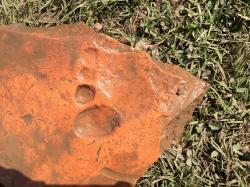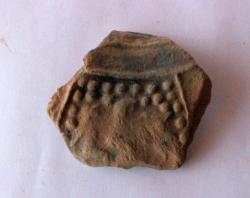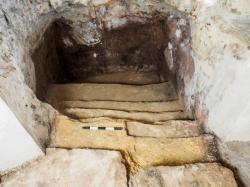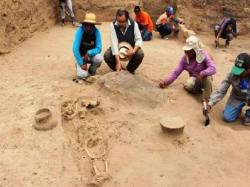INSTITUT SUPERIEUR D'ANTHROPOLOGIE
INSTITUTE OF ANTHROPOLOGY
ONLINE COURSES / COURS A DISTANCE
FALL TERM : OCTOBER 2015
REGISTER NOW
ROYAUME UNI –  Vindolanda - Nowhere gets you closer to the Romans on Hadrian’s Wall than the fort and settlement of Vindolanda, the extraordinary hoard of personal artefacts gives you a unique insight into the lives of people living here 2000 years ago. The latest addition to the collection of artefacts from the current excavation has certainly made an impression on everyone. Someone 2000 years ago quite literally put their foot in it and as a result a volunteer digging at the site has unearthed a tile with a clear imprint of a human foot that accidentally, or perhaps mischievously stood on the freshly made object. The partial print of a right foot, thought to be comparable with that of an adolescent has been dated to 160-180 CE. Many thousands of tiles have been found at Vindolanda, some occasionally with the imprint of an animal left behind but this is the first time a human print has been discovered at the site.
Vindolanda - Nowhere gets you closer to the Romans on Hadrian’s Wall than the fort and settlement of Vindolanda, the extraordinary hoard of personal artefacts gives you a unique insight into the lives of people living here 2000 years ago. The latest addition to the collection of artefacts from the current excavation has certainly made an impression on everyone. Someone 2000 years ago quite literally put their foot in it and as a result a volunteer digging at the site has unearthed a tile with a clear imprint of a human foot that accidentally, or perhaps mischievously stood on the freshly made object. The partial print of a right foot, thought to be comparable with that of an adolescent has been dated to 160-180 CE. Many thousands of tiles have been found at Vindolanda, some occasionally with the imprint of an animal left behind but this is the first time a human print has been discovered at the site.
http://www.vindolanda.com/_blog/press-releases/post/ancient-footprint-discovery-leaves-lasting-impression-at-vindolanda/
INDE –  Azhagankulam - Renewed excavation from May at Azhagankulam village in Ramanathapuram district, Tamil Nadu, has thrown up fresh evidence that it was an important trading post between the Sangam Pandyas and the Romans from circa 50 BCE to circa 500 CE. Archaeologists from the Tamil Nadu Department of Archaeology, who are taking part in the excavation, said Azhagankulam, Arikkamedu in Puducherry and Pattanam (Muziris) in Kerala formed a troika of trade centres between Rome and the Tamil country during the Tamil Sangam age. Azhagankulam is about three km from the sea, near the area where the Vaigai river enters the sea. The State Department of Archaeology had earlier excavated the site in 1986-87 and again for five seasons in the 1990s. Those excavations revealed the trade link between the ancient Tamil country and the Mediterranean region. The excavation under way now at Azhagankulam has yielded broken Roman Amphora jars, Mediterranean pottery, embossed Roman potsherds, copper coins, Chinese Celadon ware, rouletted ware, potsherds with Tamil Brahmi letters, a potsherd with a swastika symbol and so on. Beads made of carnelian, quartz and glass were found. Of the five trenches, four were laid in the Kottaimedu area. They yielded Roman amphorae (jars for storing wine), two copper coins, roofing tiles, black and red potsherds. A trench dug at Parithikaadu near the seashore yielded three corroded copper coins. Archaeologists emphasised that the Roman antiquities thrown up from the renewed excavation at Azhagankulam proved once again the trade contacts between the Pandya rulers and the Romans. Madurai was the capital of the Pandya country and Ramanathapuram came under the Madurai region. Roman gold coin hoards had been found at Utthamapuram, Nathampatti and Karivalamvandha Nallur. “From circa 50 BCE, the Roman context occurs at Azhagankulam. The Pandyas had trade contacts with the Yavanas. The Romans bought pearls from the Pandya country. The contacts lasted till 500 CE,” said an archaeologist who had taken part in the earlier excavations at Azhagankulam. Those excavations yielded three Roman coins. The legend on them showed that Roman emperors Valentine II (regnal years 383 CE to 395 CE) and Arcadius (regnal years 395 CE to 408 CE) issued them. Square copper Pandya coins were also found. The Mauryan context at Azhagankulam was revealed, with the occurrence of the northern black polished ware (elite tableware used by the wealthy) and punch-marked coins. Azhagankulam, Arikkamedu and Korkai in the Tamiraparani basin on the east coast and Muziris on the west coast saw flourishing trade between the ancient Tamil country and the Romans, the archaeologist added.
Azhagankulam - Renewed excavation from May at Azhagankulam village in Ramanathapuram district, Tamil Nadu, has thrown up fresh evidence that it was an important trading post between the Sangam Pandyas and the Romans from circa 50 BCE to circa 500 CE. Archaeologists from the Tamil Nadu Department of Archaeology, who are taking part in the excavation, said Azhagankulam, Arikkamedu in Puducherry and Pattanam (Muziris) in Kerala formed a troika of trade centres between Rome and the Tamil country during the Tamil Sangam age. Azhagankulam is about three km from the sea, near the area where the Vaigai river enters the sea. The State Department of Archaeology had earlier excavated the site in 1986-87 and again for five seasons in the 1990s. Those excavations revealed the trade link between the ancient Tamil country and the Mediterranean region. The excavation under way now at Azhagankulam has yielded broken Roman Amphora jars, Mediterranean pottery, embossed Roman potsherds, copper coins, Chinese Celadon ware, rouletted ware, potsherds with Tamil Brahmi letters, a potsherd with a swastika symbol and so on. Beads made of carnelian, quartz and glass were found. Of the five trenches, four were laid in the Kottaimedu area. They yielded Roman amphorae (jars for storing wine), two copper coins, roofing tiles, black and red potsherds. A trench dug at Parithikaadu near the seashore yielded three corroded copper coins. Archaeologists emphasised that the Roman antiquities thrown up from the renewed excavation at Azhagankulam proved once again the trade contacts between the Pandya rulers and the Romans. Madurai was the capital of the Pandya country and Ramanathapuram came under the Madurai region. Roman gold coin hoards had been found at Utthamapuram, Nathampatti and Karivalamvandha Nallur. “From circa 50 BCE, the Roman context occurs at Azhagankulam. The Pandyas had trade contacts with the Yavanas. The Romans bought pearls from the Pandya country. The contacts lasted till 500 CE,” said an archaeologist who had taken part in the earlier excavations at Azhagankulam. Those excavations yielded three Roman coins. The legend on them showed that Roman emperors Valentine II (regnal years 383 CE to 395 CE) and Arcadius (regnal years 395 CE to 408 CE) issued them. Square copper Pandya coins were also found. The Mauryan context at Azhagankulam was revealed, with the occurrence of the northern black polished ware (elite tableware used by the wealthy) and punch-marked coins. Azhagankulam, Arikkamedu and Korkai in the Tamiraparani basin on the east coast and Muziris on the west coast saw flourishing trade between the ancient Tamil country and the Romans, the archaeologist added.
http://www.thehindu.com/news/national/tamil-nadu/excavation-in-the-tn-azhagankulam-was-in-the-big-league/article7368216.ece
ISRAEL –  Jerusalem - A Jerusalem family ripping up its living room floor found a staircase lost for 2,000 years, leading to a large ritual bath carved out of bedrock. It took the family some years to call in the authorities and show them the discovery beneath their house, in the Jerusalem neighborhood of Ein Kerem. Throughout the interim, the family blocked off the entrance to the mikveh with wooden doors, and simply continued to live over it. When they did call in the Israel Antiquities Authority, beneath the doors, the archaeologists found the carved stone staircase leaving to a big mikveh, 3.5 meters in length and 2.4 meters wide, with a depth of 1.8 meters. The rock-hewn bath was meticulously plastered according to the laws of purity appearing in halacha. The staircase leads to the bottom of the immersion pool. Carved stone is hard to date, but pottery vessels discovered inside the ritual bath date to the time of the Second Temple (first century CE). The mikveh also shows traces of fire that might constitute evidence of the destruction following the Jewish Revolt of 66-70 CE. Also attesting to the period were fragments of stone vessels. Those became common during the Second Temple period, because stone cannot be contaminated and remains pure. The neighborhood of Ein Kerem is sacred to Christianity because of its identification with a "city of Judah” – the place where according to the New Testament, John the Baptist was born, and where his pregnant mother Elisabeth met with Mary, mother of Jesus, Re'em says. Yet archaeological remains in and around Ein Kerem from that era (the Second Temple period) are rare, and fragmented.
Jerusalem - A Jerusalem family ripping up its living room floor found a staircase lost for 2,000 years, leading to a large ritual bath carved out of bedrock. It took the family some years to call in the authorities and show them the discovery beneath their house, in the Jerusalem neighborhood of Ein Kerem. Throughout the interim, the family blocked off the entrance to the mikveh with wooden doors, and simply continued to live over it. When they did call in the Israel Antiquities Authority, beneath the doors, the archaeologists found the carved stone staircase leaving to a big mikveh, 3.5 meters in length and 2.4 meters wide, with a depth of 1.8 meters. The rock-hewn bath was meticulously plastered according to the laws of purity appearing in halacha. The staircase leads to the bottom of the immersion pool. Carved stone is hard to date, but pottery vessels discovered inside the ritual bath date to the time of the Second Temple (first century CE). The mikveh also shows traces of fire that might constitute evidence of the destruction following the Jewish Revolt of 66-70 CE. Also attesting to the period were fragments of stone vessels. Those became common during the Second Temple period, because stone cannot be contaminated and remains pure. The neighborhood of Ein Kerem is sacred to Christianity because of its identification with a "city of Judah” – the place where according to the New Testament, John the Baptist was born, and where his pregnant mother Elisabeth met with Mary, mother of Jesus, Re'em says. Yet archaeological remains in and around Ein Kerem from that era (the Second Temple period) are rare, and fragmented.
http://www.haaretz.com/life/archaeology/1.663877
PEROU –  Bola de Oro-El Triunfo - Archaeologists discovered 14 pre-Inca tombs and a Mochica temple dating back to around 4,000 years ago in the region of Lambayeque. Walter Alva Alva and Edgar Bracamonte Lévano found 14 tombs at Bola de Oro-El Triunfo with a majority of them belonging to the Sican or Lambayeque cultures and the rest from Moche and Chimu periods, reports El Comercio. A Lambayeque tomb was found with interesting items including a gold piece that would be an epilator (item used to remove hair). The gold piece was made with a representation of Naylamp and the the traditional mask of winged eyes. Other found items include pottery, small copper ornaments, silver and gilded copper birds and other ceremonial items such as knives, reports El Comercio. Of particular interest to Alva was the discovery of a Late Moche ceramic vessels fragment. Normally found in La Libertad, this indicates that the culture at Bola de Oro-El Triunfo had contact with the Moche culture. Just last month another pre-Inca tomb was discovered inland from Chimbote.
Bola de Oro-El Triunfo - Archaeologists discovered 14 pre-Inca tombs and a Mochica temple dating back to around 4,000 years ago in the region of Lambayeque. Walter Alva Alva and Edgar Bracamonte Lévano found 14 tombs at Bola de Oro-El Triunfo with a majority of them belonging to the Sican or Lambayeque cultures and the rest from Moche and Chimu periods, reports El Comercio. A Lambayeque tomb was found with interesting items including a gold piece that would be an epilator (item used to remove hair). The gold piece was made with a representation of Naylamp and the the traditional mask of winged eyes. Other found items include pottery, small copper ornaments, silver and gilded copper birds and other ceremonial items such as knives, reports El Comercio. Of particular interest to Alva was the discovery of a Late Moche ceramic vessels fragment. Normally found in La Libertad, this indicates that the culture at Bola de Oro-El Triunfo had contact with the Moche culture. Just last month another pre-Inca tomb was discovered inland from Chimbote.
http://www.peruthisweek.com/news-new-pre-inca-tombs-and-mochica-temple-found-106855